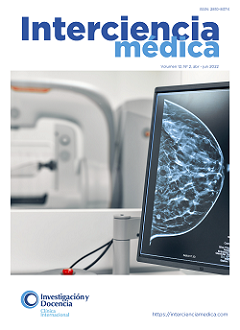Tumor Phyllodes de la mama
DOI:
https://doi.org/10.56838/icmed.v12i2.91Keywords:
phyllodes tumor, quadrantectomy, mitotic rateAbstract
Introduction Phyllodes tumor (PT) is a rare tumor of the breast, representing less than 1% of all breast neoplasms (1) and 2 to 3% of fibroepithelial tumors (7). This neoplasm is classified as: Benign PT, Borderline PT and Malignant PT (Norris and Taylor-WHO) (9). Objective To carry out a review about the diagnosis and treatment of phyllodes tumor. Development PTs are fibroepithelial neoplasms that according to stromal cellularity, nuclear atypia, mitotic rate, heterologous elements are classified as: benign, borderline and malignant (1). The maximum incidence occurs between 35-55 years. Imaging diagnosis is based on the use of mammography, ultrasound, magnetic resonance imaging and radioguided core biopsy. Optimal surgical management is the fundamental tool in PT. There is controversy about the use of adjuvant treatment with radiotherapy and chemotherapy. Conclusions: PT is a benign neoplasm of the breast, surgery is the treatment of choice. The free edge greater than 1 cm recommended by the NCCN is predictive of a lower percentage of local recurrence. Complementary treatments with radiotherapy and chemotherapy are controversial.
Downloads
Downloads
Published
Issue
Section
License
Copyright (c) 2022 Gabriela Calderón V., Alberto Pajuelo M., Henry Guerra M., Miguel de la Cruz S., Rowena Hammond C

This work is licensed under a Creative Commons Attribution 4.0 International License.














